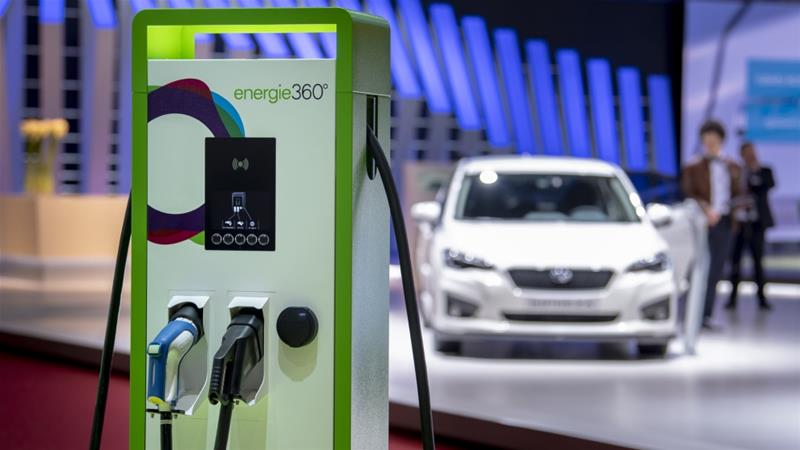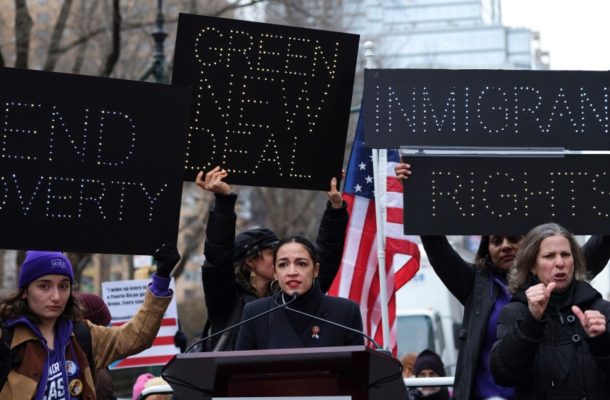The US Senate on Tuesday defeated a proposal to take up the Green New Deal in a vote Democrats called a "sham" and a "stunt".
Senators voted 57-0 against proceeding with debate on the proposal, which seeks to combat climate change.
Forty-three Democrats voted "present" to protest against the vote. Three Democrats, as well as an independent senator, joined all 53 Republicans to vote against the procedural motion.
Senate Majority Leader Mitch McConnell scheduled the vote to attempt to force Democrats to take a stand on the proposal before the 2020 presidential elections. Republicans contend the plan may sound like a "neat idea" for larger cities, but would "kill entire domestic industries" and jobs by "basically outlawing the only sources of energy that working-class and middle-class families can actually afford".
But Democrats criticised Tuesday's vote and Republican comments surrounding it, saying "climate change is not a joke".
Ed Markey, the Green New Deal's main sponsor in the Senate, said mocking climate change is "shameful".
And Alexandria Ocasio-Cortez, the main author in the House, accused Senate Republicans of "costing us lives [and] destroying communities" by delaying debate on the bill.
"I wish it didn't have to cost so much, but I'm going to turn 30 this year, and the entire 30 years of my life we did not make substantial investments to prepare our entire country for what we knew was coming so now it's coming all up at the end," Ocasio-Cortez said during a committee hearing on Tuesday. "We have the choice to lower the cost now because I can tell you the cost of pursuing a Green New Deal will be far less than the cost of not passing it."
So what does the Green New Deal outline for the US to solve the climate crisis? Here are the five key areas the deal seeks to address:
1. Net-zero greenhouse gas emissions
Stating that "human activity is the dominant cause of observed climate change," the resolution seeks to halt the adverse effect of global warming and rising sea levels.
The Green New Deal cites UN and US government findings - the Special Report on Global Warming of 1.5 degrees C by the Intergovernmental Panel on Climate Change and the Fourth National Climate Assessment by the US Global Change Research Programme.
The Green New Deal warns of catastrophic consequences if average temperatures continue to increase, including intensifying heat waves, worsening wildfires, increasing mass migration and environmental instability, lowering annual economic output and causing major damage to coastal real estate.
The resolution declares that the United States, which is "responsible for a disproportionate amount of greenhouse gas emissions," should take a "leading role in reducing emissions through economic transformation".
{articleGUID}
The crux of the initiative is that the federal government bears the responsibility to transition the economy towards carbon neutrality, which is the state of having no carbon footprint. By definition, this would necessitate dramatically fewer carbon dioxide emissions and vastly more carbon removal, through storage or sequestration.
Critics deride the plan as unrealistic, arguing that to fulfil "100 percent of the power demand in the United States through clean, renewable, and zero-emission energy sources" is not feasible.
2. Creation of new jobs
The Green New Deal states that the construction of such a post-carbon economy would "create millions of good, high-wage jobs and ensure prosperity".
It also states the context of declining US life expectancy and deepening income inequality, proposing a new industrial mobilisation "on a scale not seen since World War II and the New Deal era".
Like the original deal conceived as a government solution to protect the American people from the ill effects of capitalism, the proposal would be a grand social contract for the 21st century.
The bold proposal touches on wide-ranging issues that go far beyond climate, from the wealth gap to the gender and racial divides.
But the inclusion of these topics hints at some of the possible - albeit politically far-fetched - funding mechanisms for the outsized programme: a 70-percent income tax on the highest earners or a new ultra-millionaire wealth tax. A more free market-oriented approach would instead favour carbon pricing or a carbon emissions tax on fuels such as coal and petrol.
Irrespective of the governmental funding source, the plan's rhetorical value rests in how it forcefully highlights, "the inadequate resources for public sector workers to confront the challenges of climate change at local, State, and Federal levels".
{articleGUID}
It is thought that much of the investment would also come from the private sector, which tax credits, research grants, and other government incentives could facilitate.
Proponents argue new jobs would likely emerge from the shift to renewable energy sources as demand for manufacturing and installing the technology to harness alternative types of power and upgrading smart electric grids will be high. Existing industries, from chemicals to cement, would also require massive labour inputs to incorporate cleaner production workflows.
3. Transport and infrastructure
As part of a larger infrastructure renewal, the Green New Deal also seeks to "remove pollution and greenhouse gas emissions from the transport sector as much as is technologically feasible".
This would be accomplished with a revitalised emphasis on zero-emissions vehicles, enhanced urban mass transit, and high-speed rail.
At present, the economic sector contributing the most to US greenhouse gas emissions is transport, at 29 percent - having reached a nine-year high in 2017. At the same time, emissions from electricity generation, 28 percent, and the industrial sector, 22 percent, have decreased in recent decades, according to the Environmental Protection Agency (EPA).
The agricultural, nine percent, commercial, seven percent, and residential, five percent, sectors are also significant emitters. One of the main projects cited in the resolution focuses on improving the energy efficiency of existing buildings and designing new structures to meet higher standards.
4. Clean air, good water, healthy food
Among the many aspects of a sustainable environment highlighted by the Green New Deal, the most notable are clean air, good water, healthy food, and access to nature.
Sustainable farming and better land-use practices that improve the food system are key in the deal, as well as to restoring and protecting habitats.
{articleGUID}
The diverse array of Green New Deal components would likely be enacted by different pieces of legislation over several years, like the New Deal itself. In many ways, the initial resolution from last month was a "request for proposals" that merely defined the scope of action.
Strategically, supporters aim to integrate the climate bills with other pillars of US economic policy, at a time when over one-third of young Americans say climate change is a factor in deciding whether to have children.
Some of the resulting job creation would be in emergency management, building resilience against climate-related disasters. The government would also champion efforts to mitigate and manage the long-term effects of global warming.
5. Pollution
The last of the five goals in the Green New Deal covers pollution, from hazardous waste site cleanup to environmental fortifications in vulnerable neighbourhoods and regions.
The deal strives to "promote justice and equity by stopping current, preventing future, and repairing historical oppression of indigenous peoples, communities of colour, migrant communities, deindustrialised communities, depopulated rural communities, the poor, low-income workers, women, the elderly, the unhoused, people with disabilities, and youth".
What do critics say about the deal?
The Green New Deal contains enormous costs, and many conservatives believe that raising taxes to pay for the initiative will drive down economic growth, send wealth overseas and fail to generate as much revenue as needed.
Opponents suggest that a programme to combat climate change to the tune of one trillion dollars a year would compete for funding with other proposed big-ticket projects, such as Medicare For All, student-loan forgiveness, and free public college tuition.
Other critics have contended that in the so-called "tax the rich" model, it would be middle-class taxpayers who would ultimately foot much of the bill.
{articleGUID}
Moreover, improved US efforts do not guarantee compliance by other countries, and opponents have argued that US products would not be able to compete with countries that do not attempt to limit their carbon emissions. However, the border tax adjustment - a global, punitive tariff on imports based on their carbon footprint - is one proposed way to account for this "free-rider" problem.

![]()
Counting the Cost
Car industry: What's the real cost of going electric?Source: aljazeera.com


Comments